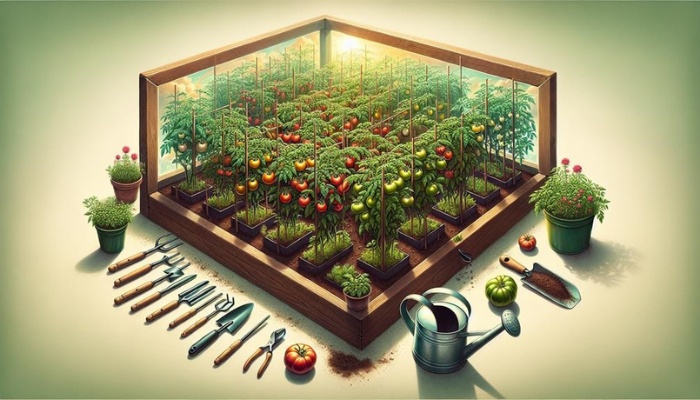Growing tomato plants in a square foot garden is akin to painting on a blank canvas; you’ve got a world of possibilities within a neatly defined space.
From planning your garden layout, selecting the best tomato varieties, and preparing the soil to ensuring your plants get the right balance of water and nutrients and outsmarting pests, there’s a lot to know. Let’s take it step by step.
Planning Your Garden Layout
Before you plant your first tomato seedling, take the time to carefully map out your garden’s layout, considering factors like sunlight exposure, soil quality, and plant spacing to ensure optimal growth.
You’ll want to select a spot where your tomatoes will receive at least 6-8 hours of direct sunlight daily.
Sunlight exposure isn’t just about quantity but quality too. Morning light is particularly beneficial for drying dew on leaves, reducing the risk of fungal diseases.
Incorporating companion planting into your layout can significantly enhance your tomatoes’ health and yield. This method involves placing plants together that mutually benefit one another.
For instance, basil not only repels pests but can also improve tomato flavor. Marigolds, on the other hand, deter nematodes and other garden pests that could harm your tomatoes.
When planning your garden, it’s also essential to consider the spacing between plants.
Tomatoes need ample space for air circulation to minimize disease risk and for their root systems to expand, ensuring they can access water and nutrients efficiently.
A square foot gardening approach, allocating one tomato plant per square foot, ensures optimal use of space while adhering to these spacing requirements.
Choosing Tomato Varieties

Having carefully planned your garden’s layout, it’s essential to select tomato varieties that best suit your space and climate conditions.
The choice between heirloom and hybrid tomatoes plays a significant role in your garden’s success, considering their distinct characteristics and how they adapt to varying climates.
Here are four critical points to guide your selection:
- Heirloom vs. Hybrid: Heirloom tomatoes are known for their rich flavor and genetic diversity, making them more adaptable to local climate conditions. However, hybrids are specifically bred for disease resistance and higher yields, which can be crucial in challenging climates.
- Climate Adaptability: Some tomato varieties thrive in cooler temperatures while others require a warmer climate to flourish. Research the climate adaptability of each variety to ensure it’s well-suited for your local weather patterns.
- Growth Habit: Determine whether determinate (bush) or indeterminate (vining) tomatoes are more suitable for your square foot garden, considering the space and support structure available.
- Maturity Time: Consider the days to maturity for each variety, especially in regions with shorter growing seasons, to ensure your tomatoes have enough time to develop fully.
Choosing the right tomato varieties involves balancing between taste preferences, growth habits, and environmental adaptability to optimize your square foot garden’s yield and health.
Soil Preparation and Planting
To ensure optimal growth and productivity of your tomatoes, prepare the soil meticulously, incorporating organic matter and ensuring proper drainage.
Begin by loosening the soil to a depth of at least 12 inches, mixing in well-rotted compost or manure to enrich the soil. This step not only boosts fertility but also enhances soil structure, promoting water retention while preventing waterlogging.
Companion planting can significantly benefit your tomatoes. Planting basil, marigolds, or carrots nearby can deter pests and diseases, creating a healthier environment for your tomatoes to thrive.
Additionally, these companions can optimize space usage in your square foot garden, ensuring you get the most out of every square inch.
Mulching techniques are equally important in soil preparation and planting. Applying a 2 to 3-inch layer of organic mulch around your tomato plants will help maintain soil moisture, suppress weeds, and regulate soil temperature.
Straw, shredded leaves, or grass clippings are excellent choices for mulch, offering the dual benefits of retaining moisture and gradually enriching the soil as they decompose.
Watering and Nutrient Management
Adequate watering and precise nutrient management are fundamental to the success of your tomatoes in a square foot garden. To ensure your plants receive the right amount of water and nutrients, consider the following strategies:
- Employ Drip Irrigation Systems: Drip irrigation delivers water directly to the soil around your plants, minimizing evaporation and ensuring that water reaches the roots where it’s most needed. This method promotes efficient water use and helps prevent diseases by keeping foliage dry.
- Understand Fertilizer Types: Use a balanced, slow-release fertilizer to provide a steady supply of nutrients. Tomatoes benefit from fertilizers with higher phosphorus content (the middle number in the N-P-K ratio) to support flowering and fruiting.
- Monitor Soil Moisture: Check the soil moisture regularly. Your tomatoes need about 1 inch of water per week, but this can vary with local weather conditions. Use a soil moisture meter or the finger test to avoid overwatering or underwatering.
- Adjust Feeding Based on Plant Stage: In the early stages, focus on nitrogen-rich fertilizers to encourage leaf growth. As plants begin to flower and fruit, switch to a phosphorus-rich fertilizer to support fruit development.
Pest Control and Harvesting
Pests, from tiny aphids to larger tomato hornworms, can devastate your plants, reducing both the quality and quantity of your harvest.
Implementing effective pest control measures and accurate disease identification is crucial. Regularly inspect your tomatoes for signs of distress, such as unusual spots or chewed leaves, to catch issues early.
Companion planting is a natural strategy to deter pests. Planting basil or marigolds near your tomatoes can repel harmful insects while attracting beneficial ones.
This method not only enhances your garden’s biodiversity but also reduces the need for chemical pesticides.
Timely harvesting plays a pivotal role in maximizing yield. Tomatoes should be picked as soon as they reach their full color to prevent overripening on the vine.
This not only ensures the best flavor but also reduces the risk of diseases and pests attracted to overripe or damaged fruit. By staying attentive to harvesting times, you’ll keep your plants healthier and more productive throughout the growing season.

